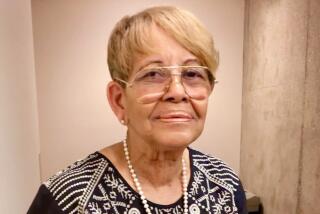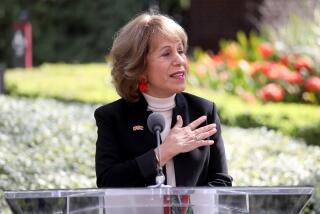Colorful Dean of USC Med School Had a Healthy Appetite for Life
- Share via
In the last 116 years, 19 noteworthy deans have swaggered through the doors of the USC School of Medicine.
But few can match “America’s family doctor,” Roger Olaf Egeberg, an outspoken public health advocate whose previous careers included mule skinner, tourist guide and aide-de-camp to Gen. Douglas MacArthur.
For the record:
12:00 a.m. Dec. 20, 2001 FOR THE RECORD
Los Angeles Times Thursday December 20, 2001 Home Edition Part A Part A Page 2 A2 Desk 1 inches; 35 words Type of Material: Correction
Gen. MacArthur--The Then and Now column in the California section Dec. 9 said that Gen. Douglas MacArthur returned to retake the Philippines with Dr. Roger Egeberg by his side in 1945. MacArthur returned to the Philippines first in the fall of 1944.
Egeberg acquired a reputation as a liberal for championing the rights of seniors and the poor. He opposed strict laws against marijuana, fought for less restrictive abortion laws and helped to found the first free health clinic in Watts.
But it was his freewheeling style, compassion and the way he could belt out the Norwegian national anthem--song of his parents’ homeland--almost any time that endeared him to many. Probably the most-quoted dean at the USC School of Medicine, he is widely remembered for the utterance: “A dean is to the students, the faculty, the alumni and the president what a fireplug is to a dog.”
Born in Chicago in 1903, he spent most of his youth divided between Gary, Ind., and Norway, where his relatives lived.
Even at 9, he had a keenly honed sense of justice. During a performance of “Uncle Tom’s Cabin” at his Gary elementary school, he crept onstage, penknife in hand, to stop Simon Legree from lashing the little star of the play with his whip.
Once he graduated from Cornell University, his fearlessness took him to the Himalayas, where he traveled by mule, studied primitive art, encountered strange customs, and risked his life in an avalanche.
He graduated from Northwestern University School of Medicine in 1929 and taught at Western Reserve University in Cleveland before entering private practice.
He met his wife-to-be at a Cornell fraternity party, where his 6-foot-4-inch, 240-pound frame attracted the attention of Margaret “Meg” Chahoon. He was equally impressed with her, and introduced himself with a rhyme: “Meg, press flesh with Ege.”
Their contrasting natures meshed well: He was ardent and adventurous; she was a sculptor whose shy, unassuming nature and “stand by her man” reticence won his lifelong devotion.
In 1940, when the Germans invaded his beloved Norway, Egeberg enlisted in the Army.
Assigned to Milne Bay, New Guinea, during World War II, he declared war on bureaucracy. More than half of Egeberg’s troops were ill with malaria, Whittier physician Murray C. Zimmerman remembered, when a Washington bureaucrat wrote a letter demanding to know what Egeberg was doing to control venereal disease. Exasperated, Egeberg wrote a ridiculously obscene poem that he attached to a letter and sent to headquarters, saying he was not concerned with VD because the only females within 100 miles were sheep.
“Roger’s salacious comments--in which he used the same four-letter verb 60 times--were circulated through the Army for a number of years,” said Zimmerman, who knew him during the war and saw the letter.
Egeberg’s angry superior sent him to Gen. Douglas MacArthur for a court-martial. A nervous Egeberg had met MacArthur just weeks earlier when their Jeeps almost collided on a one-way road. MacArthur’s Jeep was going the wrong way, but when Egeberg saw the four stars on its bumper, he steered his own vehicle into the mud and kept his mouth shut.
Now, he was standing at attention in MacArthur’s office. The general looked him up and down and said, “I hear you’re having a little trouble. . . . Doc! Siddown! Have a cigar and tell me about it!”
Egeberg had not only won MacArthur’s attention with his letter and poem, but with his program for eradicating mosquitoes’ feeding and breeding grounds. MacArthur made Egeberg his personal physician and aide-de-camp in charge of organizing emergency field hospitals.
In 1945, three years after MacArthur had retreated from the Philippines, he returned to retake the islands with Egeberg by his side. As the war ended, Egeberg watched MacArthur accept the Japanese surrender aboard the battleship Missouri.
When Egeberg retired, he held the rank of colonel and had earned the Bronze Star and the U.S. Legion of Merit, among many decorations.
For the rest of his life, the tough-talking doctor continued to wash out his own socks each night, Army fashion. He also wore white satin pajamas to bed and drank a vegetable juice concoction each morning.
In 1946, Egeberg came to Los Angeles as chief of medicine at the Veteran Administration’s James Wadsworth Hospital in West Los Angeles. Combining his work as an internist, administrator and researcher, he taught at UCLA and pioneered research on a flu-like virus known as valley fever (coccidioidomycosis).
In the late 1950s, when he headed a citizens’ committee on health care needs in California, a member asked him why he used four-letter words while chairing a public meeting. “Because it wakes up the men and titillates the women,” Egeberg replied.
Always the prankster, Egeberg in 1959 began a tradition at Los Angeles County-USC Medical Center: giving promoted colleagues live animals, such as goats or snakes.
When he gave up his job in 1964 to accept the USC deanship, his staff chipped in and bought him his promotion gift--a donkey.
Often using snakes in his and students’ research, Egeberg once had a snake salesman deposit a dozen or more snakes on his living room carpet during a cocktail party. Sitting back, he watched the reaction with glee.
He mentored premed students and doctors-in-training, who were often guests in his home. “For potential medical students he looked beyond their grades and always asked them, ‘When was the last time you cried?’ ” said one of his four children, Sara McEre of Santa Barbara. “He wanted to see what kind of heart they had.”
Egeberg’s five-year deanship paralleled an era of student revolt, antiwar activism and the Watts riots. When student activists asked for $500 to go to Selma, Ala., to work for desegregation, Egeberg gave them the money from a special fund. When school officials complained, he repaid it from his own pocket. In the wake of the Watts riots in 1965, Egeberg realized his dream of creating a free health clinic: a cluster of trailers in the shadow of a public housing project.
In 1969, he moved to Washington when President Nixon named him assistant secretary for health and scientific affairs in the Department of Health, Education and Welfare. He was Nixon’s second choice--the first was deemed too liberal--but Egeberg turned out to be even more so.
Egeberg openly criticized Health, Education and Welfare Secretary Robert H. Finch for failing to take his advice on health matters. He also blasted Nixon and his advisors for ignoring him and failing to appropriate enough money for health care.
He never lacked the fire in the belly, but he didn’t have the stomach for cutthroat, back-stabbing White House politics. In 1971, he left after clashes over his managerial skills. But Nixon still had use for his talents: Egeberg became a special consultant to the president on health affairs and chief medical officer of Medicare.
In 1983, Egeberg wrote a book, “The General: MacArthur and the Man He Called ‘Doc,’ ” a tribute to his beloved friend and superior officer who had died in 1964.
Egeberg died in Washington in 1997.
“Egeberg was larger than life and cast a very big shadow,” said Gordon Cohn, retired USC Medical School fund-raiser and public relations officer. “He had the largest heart and greatest concern for people of all strata of society.”
More to Read
Sign up for Essential California
The most important California stories and recommendations in your inbox every morning.
You may occasionally receive promotional content from the Los Angeles Times.










